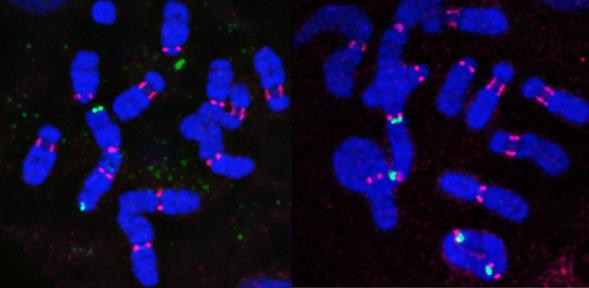
Chromosome Biology
Keywords
Vertebrate chromosome, centromere, minichromosome, topoisomerase II, telomere
Research interests
Research in the chromosome biology group aims to explore the relationship between the structural organisation of vertebrate chromosomes and their function. Previously we have derived a minimal human chromosome, studied de novo telomere formation and genetically manipulated cultured vertebrate cells in order to study various chromosomally-associated proteins (e.g. the TTAGGG repeat binding factor TRF1 and Topoisomerase II (alpha and beta). Current research focuses on:
- The functional organisation of vertebrate centromere domains
- The role of toposiomerase II at the centromere and the influence of SUMOylation
- Topoisomerase II and the Catenation Checkpoint
The functional dissection of human centromeres is difficult because of the lack of “landmarks” within the megabases of alpha satellite DNA found in these domains. The generation of a large series of deletion derivatives of one particular centromere (the human X) revealed the domain to be asymmetrically organised, with an active subdomain anchored close to the Xp-edge. In addition, we identified a major site of topoisomerase II cleavage within this domain that can shift, if juxtaposed with a telomere, suggesting that this enzyme recognises an epigenetic determinant within the alpha satellite-associated centromeric chromatin. Similar topo II susceptible sites have been identified within other human centromeres. In addition, others have mapped topo II cleavage sites close to candidate centromeric DNA sequences on the chromosomes of parasitic protozoa (Plasmodium and Trypanosoma). These observations suggest that topoisomerase II is recognising some fundamental aspect of the eukaryotic centromere.
We have found that the depletion of topoisomerase II alpha from human cells leads to a disorganised metaphase plate and an increased rate of minichromosome missegregation. Shortening of the distance across metaphase sister centromeres and the abnormal persistence of PICH-coated connections between segregating chromatids, suggest that this may be linked to structural alterations within the centromere domain. We are using various conditional knock-out and knock-down cell lines to investigate the role of topoisomerase II at the vertebrate centromere and how it is the influenced by SUMOylation, as well as its contribution in shaping the mitotic chromosome.
